#early medieval fashion
Explore tagged Tumblr posts
Text


Viking Fashion ✦ Source
#viking#vikings#viking wardrobe#viking wear#viking fashion#viking dress#early medieval wear#early medieval wardrobe#early medieval dress#early medieval fashion#early medieval period#viking period#early medieval#medieval#viking age#norse#medieval norse fashion#medieval nordic fashion#norse fashion#nordic fashion#ancient norse#dress#wear#fashion#wardrobe
2 notes
·
View notes
Text

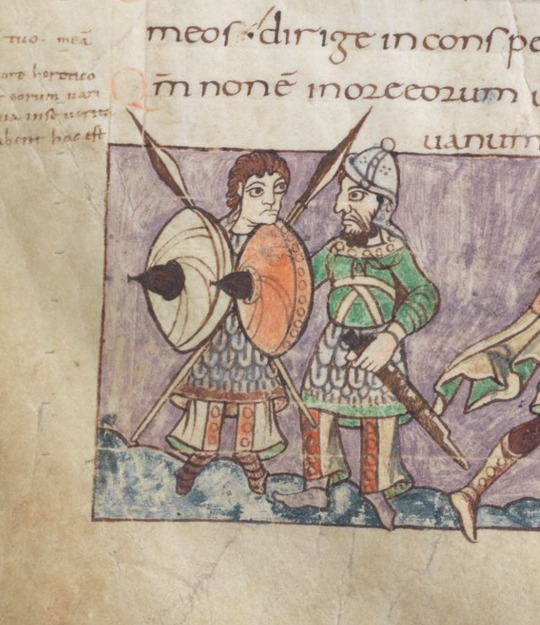

Caroligian clothing for episode 98 of Passion Médiévistes, based off of the Stuttgart Psalter !
6K notes
·
View notes
Text

Pendant with the Coronation of the Virgin, elephant ivory behind rock crystal, North French or Netherlandish, early 15th Century
From the Met Museum
#pendant#jewellery#fashion#fashion history#north french#french#netherlandish#early 15th century#15th century#1400s#medieval#ivory#rock crystal#gold
593 notes
·
View notes
Text
A little detail I appreciate about Pentiment are the head coverings. They can actually tell you little things about the characters. First off, the doffing of caps indoors is a great touch. Just like in period, most womens' heads are covered once they're married. You see that with Eva Gertneryn. She wears her hair uncovered for most of Act I, except at the end where she's seen with Otto in the town square, wearing a kerchief and straw hat. This might symbolize that she's publicly accepted Otto's courtship and she's off the 'market'. For Acts II and III, her hair is covered. Pre-modern, a lot of feminine head coverings were as much for practicality as social modesty. I love the variety in-game (especially Hedwig's turban). Magdalene's not married, but she wears a wrapped cloth like a headband to keep her voluminous hair (inherited from her Mom, who wore hers the same way) out of the way as she works. They also help keep hair clean, which is helpful in a world where submerged baths are uncommon. Magdalene is clearly of a higher social status than some of the peasant girls in her age group if she has the time to comb her hair multiple times a day to keep it looking presentable.
I like that Else Mülleryn actually UNCOVERS her hair as time progresses. In Act III you can see it out in a braid, which might allude to her renewed sense of confidence and vitality post-Lenhardt (her clothing also becomes a lot more casual-looking, ideal for chasing grandkids). Speaking of widows, I have a feeling Ottilia never covered her hair, even when her husband was kicking. Because fuck supposed Christian modesty norms.
168 notes
·
View notes
Text



the previously posted sketch of a 17th outfit has been created
#medieval#reenactment#larp#character art#character design#17th century#early modern history#historical costuming#historical fashion#history#sewing#costume design#costuming
20 notes
·
View notes
Note
Vanya, can you tell us about your first meeting with Francis ?

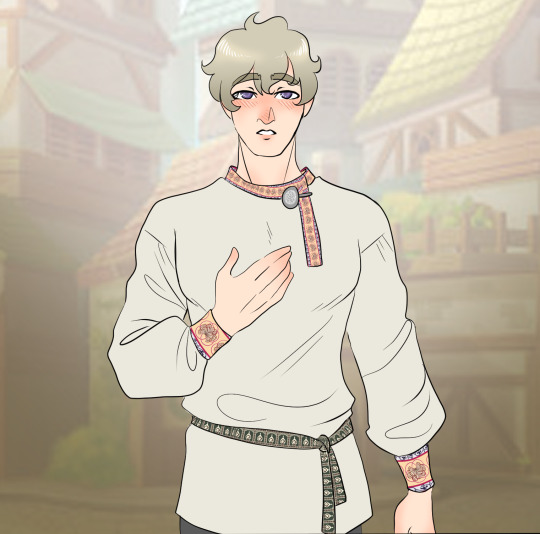
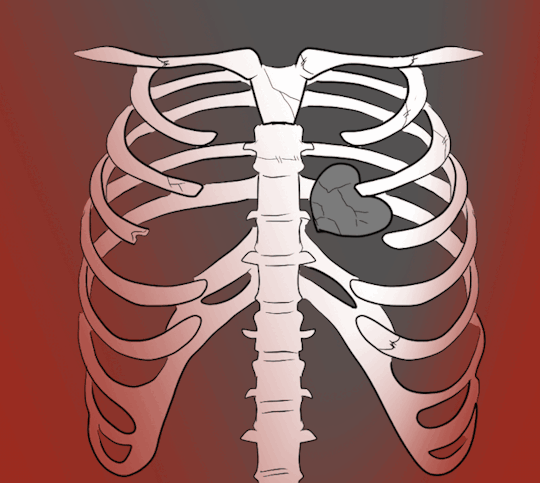

It was somewhere around the 11th century, when he first (properly) laid eyes upon Francis. He had no idea who he was, only that they were alike, and he felt something warm inside for the first time in a very long time. That's where it began. Their 'official' introduction was much later, but as fellow nations they did occasionally hear of each other. But very rarely did see each other in the flesh. Ivan isn't entirely sure if Francis even knew who he was for a very long time.
#if this fashion is garbage and wrong please avert your eyes#i am absolutely miserable at researching early-mid medieval anything#and why on earth would ivan even be there to begin with#nobody knows - especially me#should ivan look more BABY? absolutely#am i capable of it? definitely not#hetalia#aph russia#hws russia#aph france#hws france#rusfra#russia/france#historical hetalia#semi-historical at least lmao
73 notes
·
View notes
Text



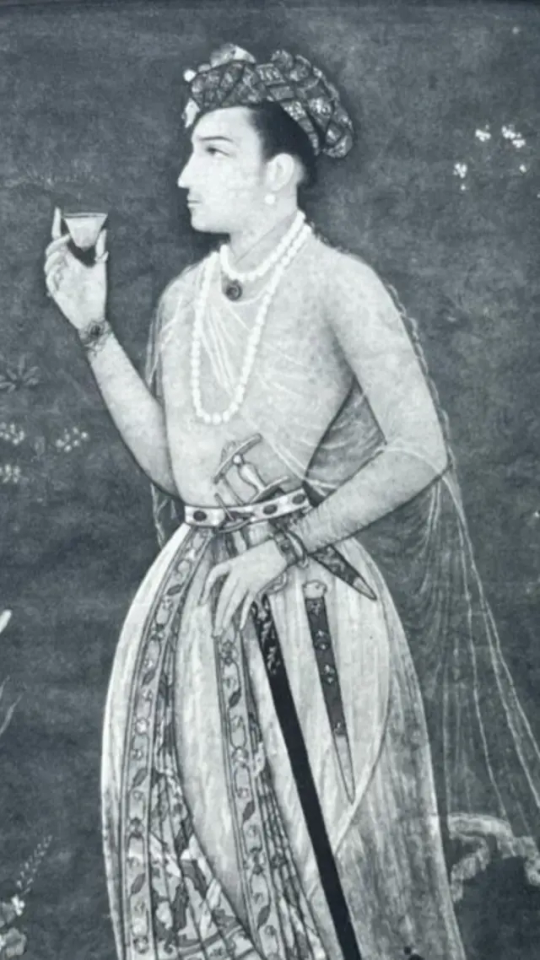





a few mid timurid dynasty (akbar-aurangzeb) prince serves ... .they hate to see you in a gorg brightly colored outfit before ur mustache has even grown in ... I wish falconry was a global phenomenon in the year 2024
#art history#medieval art#medieval history#medieval manuscripts#early modern art#mughal history#mughal empire#mughal art#akbar i#jahangir#shahryar mirza#dara shikoh#shah jahan#aurangzeb#murad bakhsh#jai singh i#maybe other guys i forgot also#fashion history#timurid dynasty
19 notes
·
View notes
Note
I loved your hair and clothes asoiaf posts! The refs are so good and so apt! As a Brienne enjoyer though i have to ask: any variants for Tarth? It's a big island, far enough from the land so it must have developed differently from the stormlands 🤔
Omg good question thank you!!
Okay so I think that there’s definitely more of a looser, casual, simpler vibe going on on Tarth bc they’re so far removed from everyone else. I think they still wear layers and long sleeves bc they’re technically in the stormlands, but the island is said to be very beautiful and lush so I figure the weather isn’t super crazy to where they have to bundle up all the time. And they still embroider and get nice dyes and fabrics bc they’re close to the coast! Essentially they can dress pretty comfortably




And for hair I’m obsessed with the idea of these medieval kind of pigtails. Since they’re more casual than Kings landing and storms end, they aren’t crazy elaborate or strict with their hair, and there’s no pressure for women to have tight updos, but they still like to make it look pretty and add some cute styles and loose veils


#thanks anon!#that actually made me think a little bit bc what would Tarth fashion be#I think the general idea is that riverlands kind of medieval idea but with a little inspiration from storms end dark ages-early Middle Ages#ASOIAF hair and clothing
185 notes
·
View notes
Text

Updated my kit, decided to take this pic on Leif Erikson Day, and forgot to upload it lol. Really proud of this
#viking#anthropology#viking age#Norse#historic fashion#reenacting#clothes#historic drip#medieval#early medieval#medieval clothing
26 notes
·
View notes
Text
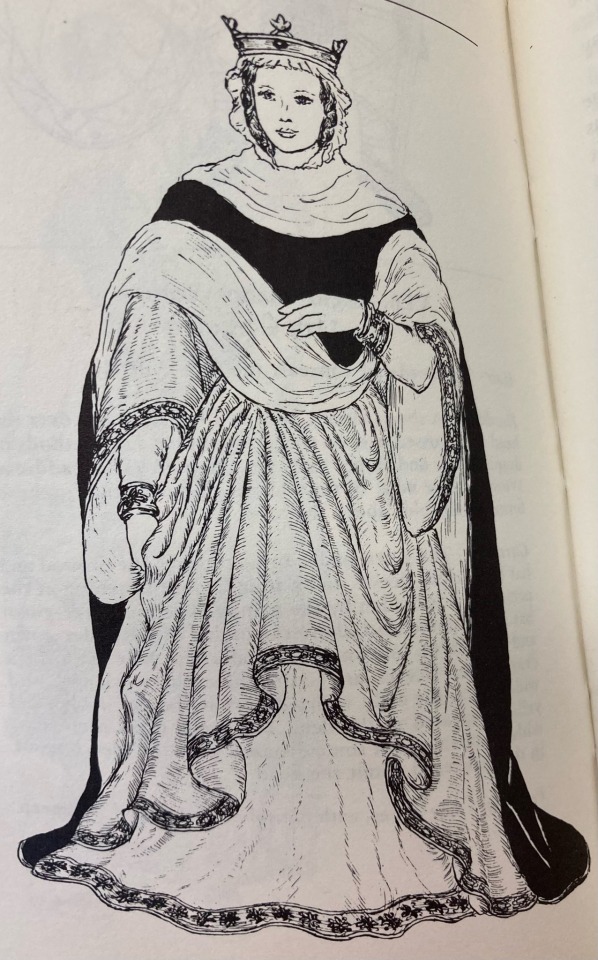
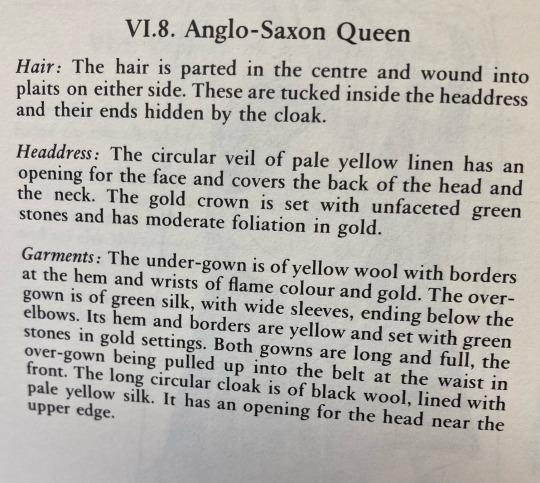
- Margot Lister, Costume
16 notes
·
View notes
Text


(x)
41 notes
·
View notes
Text

Viking Fashion ✦ Source
#medieval#middle ages#medieval period#early medieval#early medieval period#early medieval wardrobe#early medieval wear#early medieval dress#early medieval fashion#viking#viking wear#viking wardrobe#viking dress#viking fashion#vikings#medieval norse fashion#medieval nordic fashion#nordic fashion#norse fashion#ancient norse#norse#nordic#fashion#wardrobe#wear#medieval fashion#medieval wear#medieval dress#medieval wardrobe#male fashion
2 notes
·
View notes
Text
Identifying J.C. Walker's Illustrations
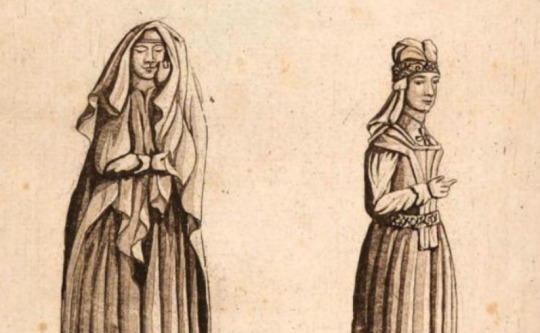
An Historical Essay on the Dress of the Ancient and Modern Irish by Joseph Cooper Walker published in 1788 was the first major work published on Irish dress history. Due to a combination of the limited information known at the time, and his erroneous assumption that Irish dress didn't change for the entirety of the Middle ages, Walker got a lot of things wrong, so his writing isn't cited much anymore. Some of his illustrations, however, are still used.
Because Walker lived before the invention of photography, he used drawings of historical Irish art created by colleagues and family to illustrate his book. I decided to track down the original works of art to see how Walker's drawings compared. I am resorting these into roughly chronological order, because Walker's lack of regard for chronology makes my head hurt.
The High Crosses, 9-10th centuries:
Ireland's high crosses have unfortunately lost a lot of their detail due to erosion, making these hard to identify. Sadly, the breeches with a fitted knee-band and the skirt gathered to a waistband look more Late Medieval or Early Modern than they do Early Medieval, so I don't think these are reliable depictions of the lost detail.
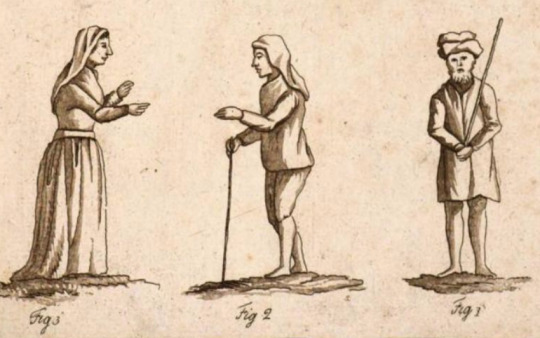
Plate 1: Figure 1 (right) is supposed to be from the Clonmacnoise Cross of Scripture. At a guess, it's based off the guard on the right arresting Jesus:
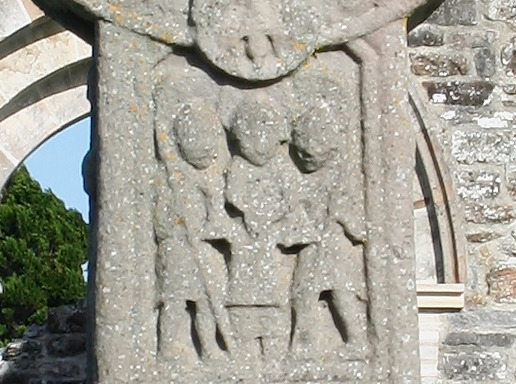
Figures 2 and 3 are based off a high cross fragment at Old Kilcullen, County Kildare. Unfortunately, I don't think the original carving survived. I initially blamed its loss on the United Irishmen, but this drawing from 1889 convinced me that acid rain was the real culprit.
Plate 5 Figure 1 is supposed to be a king from Muiredach's cross. The closest image I could find on the actual cross is Cain killing Able:

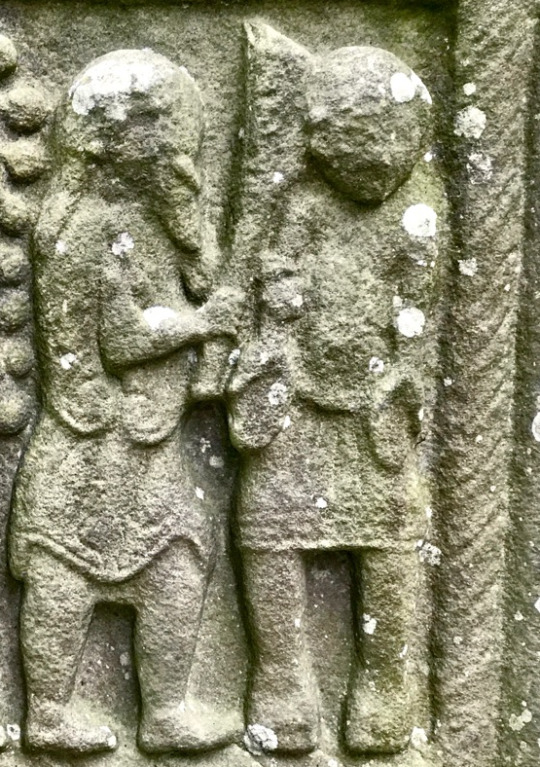
Ironically, Cain and Able have more embellishment on their clothes than the "king" based off of them.
12th century:
Plate 1 Figure 5 is from the capital of an arch at St. Saviour's Priory in Glendalough, County Wicklow. The drawing gives the impression that the sides of the head were shaved and the hair was deliberately curled at the end. In the actual carving, the hair is slicked back at the sides and interlaced with adjacent design elements. These are stylistic elements of Irish Romanesque art and not intended to be a realistic depiction of an Irish hairstyle.
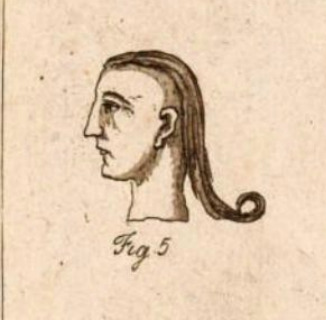

13th century:
Plate 4 is the late 13th century effigy of Felim O'Connor, Dominican Priory of St. Mary, Roscommon with a frontal of gallowglasses added in the 15th c.
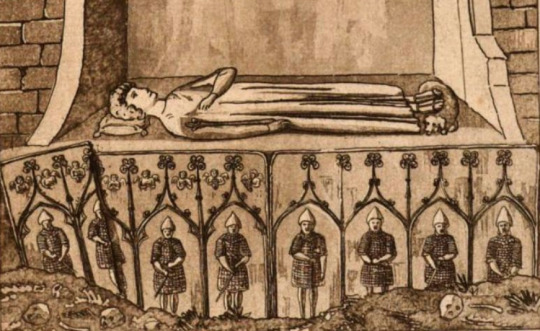
This drawing is pretty accurate, although the gallowglasses are lacking some details like their quilted cloth gambesons.

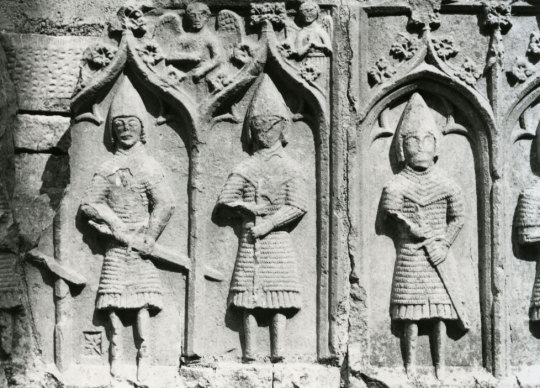
photos by Edwin Rae
I cannot find a good photo of Felim O'Connor's effigy, but Conor O'Brien's contemporary effigy at Corcomroe Abbey, County Clare wears the same style of clothing.
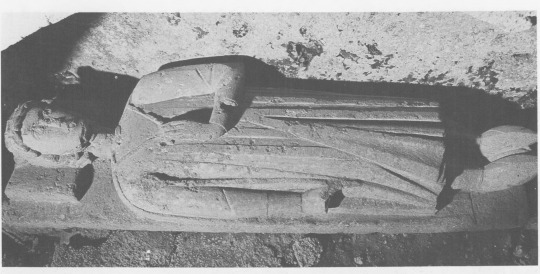
13-14th century?
Plate 6 is based on a sculpture from Athassel Priory in County Tipperary. I can't find a solid date for this one. Athassel Priory was built c1200 and then burnt and rebuilt twice before it was dissolved in 1541. The clothing style of the carving makes me think it's from the earlier part of this time frame.
The biggest thing the drawing gets wrong is the gender. This is a man, not a woman. The "necklace pendent" on his chest might have actually been a brooch holding his cloak, but the sculpture is now too damaged to tell. The drape of fabric at his side, which Walker calls a train, is actually the edge of his cloak. The drawing also leaves out the way his become more fitted below the elbow.
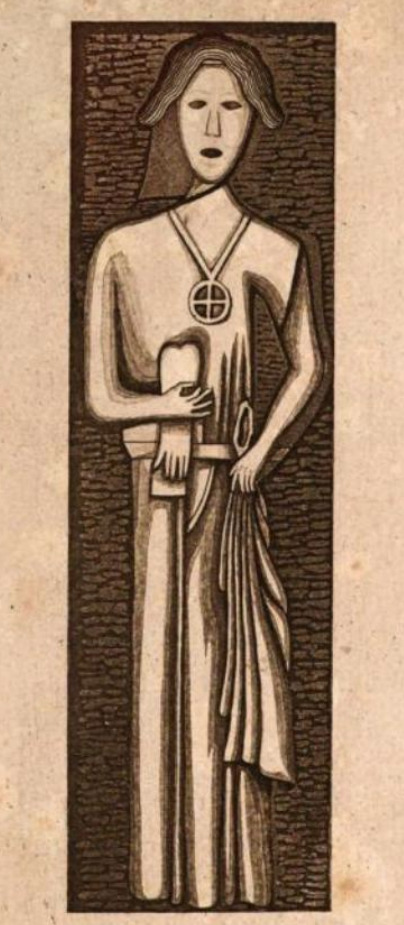
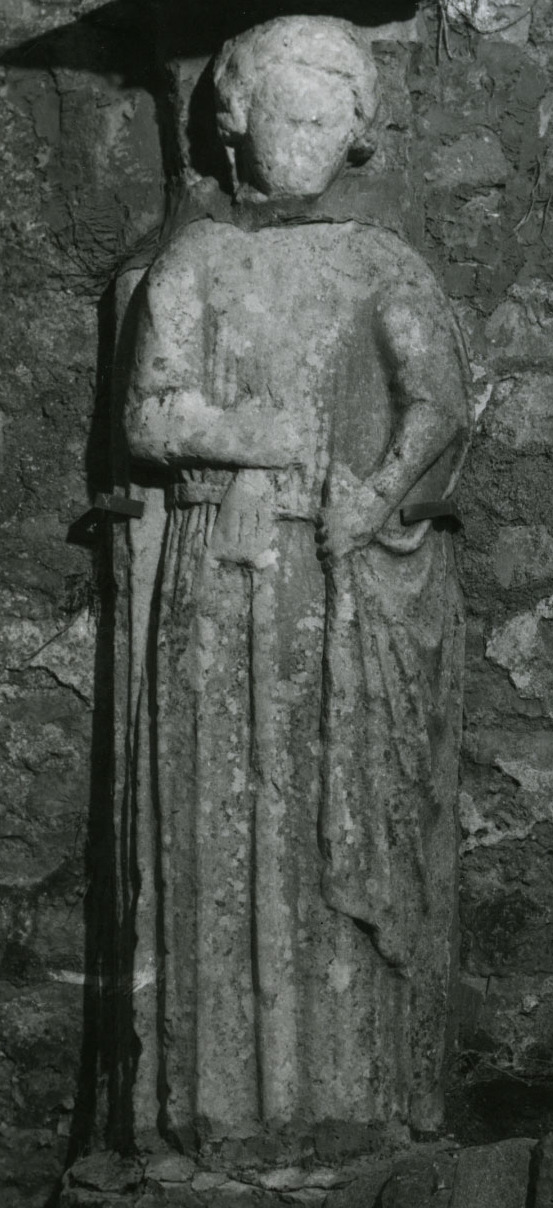
15th century:
Plate 3 Figures 1-3 are based off a painting at Knockmoy Abbey.
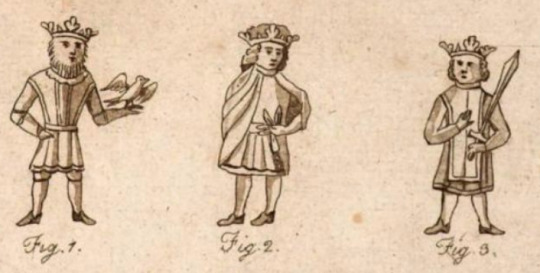
I'm pretty sure those are houppelandes on the left and center figures. This continental fashion influence shows up elsewhere in 15th c. Ireland (Dunlevy 1989). The drawing omits the massive houppelande sleeves and shortens their hems.
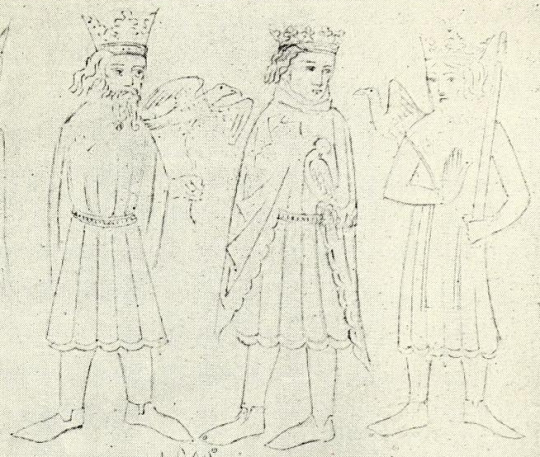
The painting is now badly weather and difficult to see. This is a more accurate drawing published in 1904. Recent photograph here
Plate 5 figure 2 and plate 1 figure 6 come from a 15th c. grave at the Dominican Friary, in Strade, County Mayo.
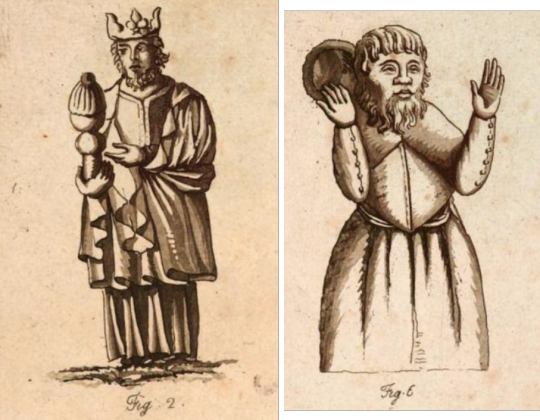
Figure 2 is a decent representation, although it adds a center front slit to the leine which I don't think is actually there. Figure 6 gets the silhouette of the cotehardie a bit wrong and omits the hanging belt accessories, but its greatest crime is that it makes the top of the hood look like a separate object. Walker actually misidenifies it as a Scotch bonnet.
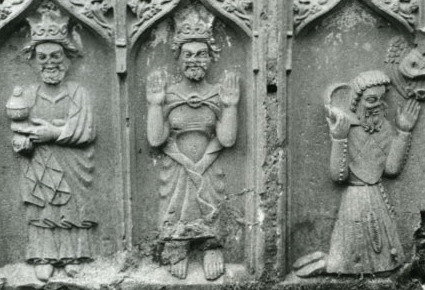
photo again by Edwin Rae
Plate 7 is Anne Plunket's effigy at St. Mary's Church, Howth, County Dublin. This drawing is decent, though the sleeves are a bit too slim. The cross necklace and belt decorations are no longer visible on the effigy.
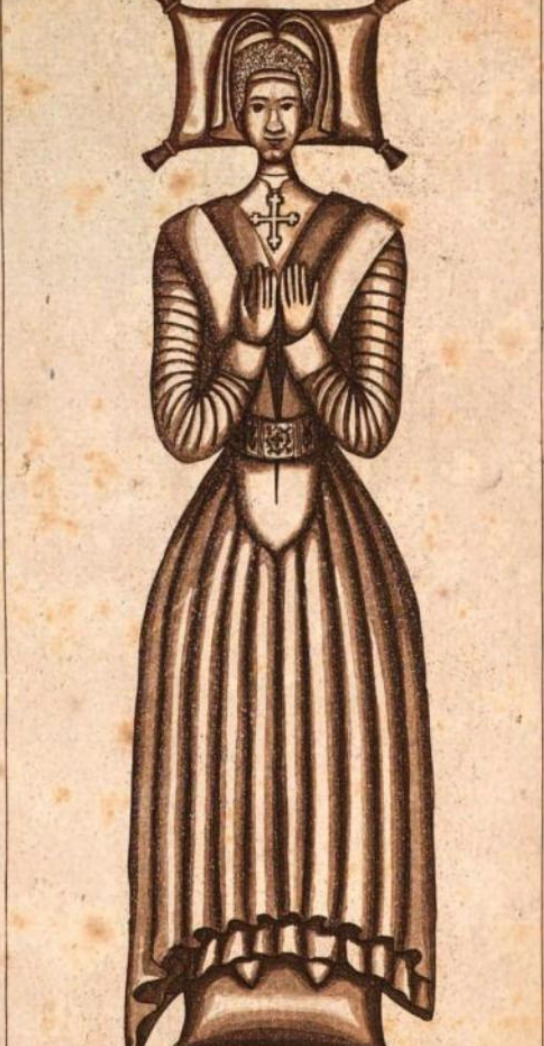
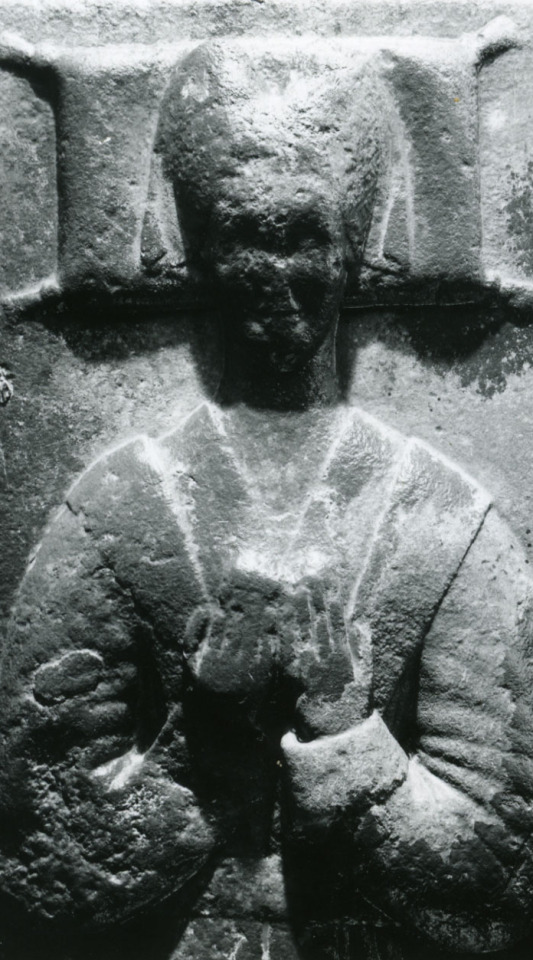
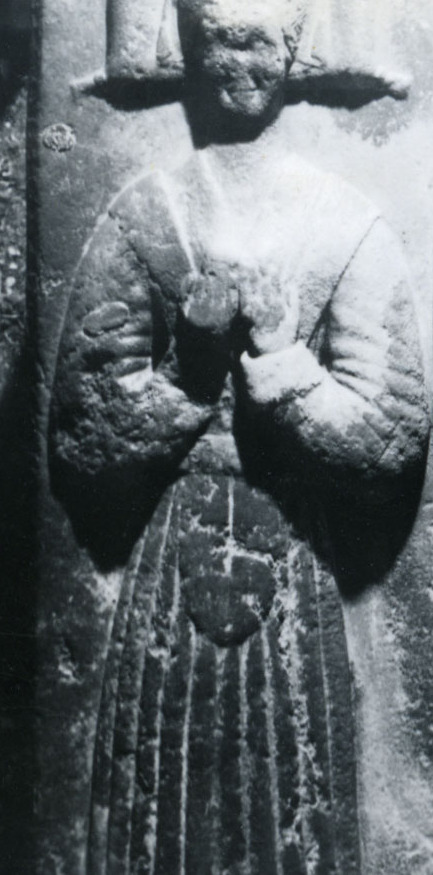
photos by MVP Edwin Rae
Plate 8 figures 1 and 2 are both based on a late 15th c. tomb at the New Abbey in Kilcullen, County Kildare. Figure 1 is based off a carving which is probably depicting St. Brigid, which makes her headwear the wimple of an abbess, not a laywoman's kerchief Walker. The drawing, however, omits her telltale crozier. The drawing makes it look like she has cuffed sleeves, but that is actually just the folds of her brat draped over her arm. It also shows her as wearing 2 layers of skirts when she is actually wearing a single lower garment with a hem circumference so large that it puddles at her feet.
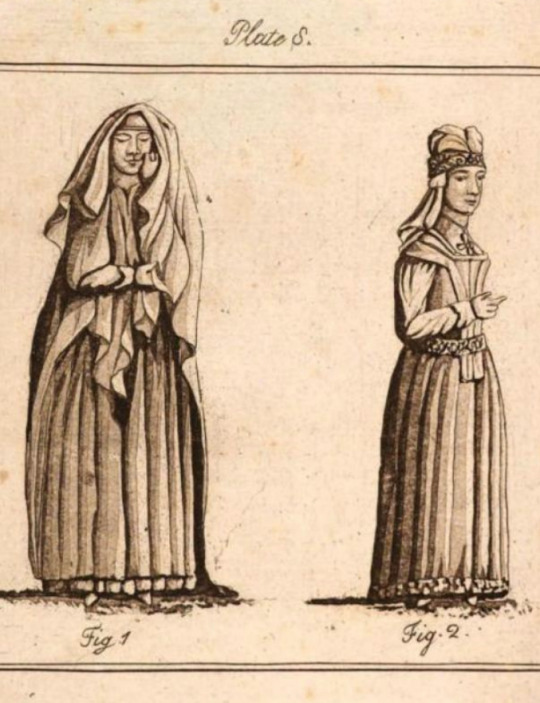

Figure 2 is based of Margaret Janico's effigy. The effigy is now too badly eroded to make out details, but it originally probably looked very similar to Margaret Janico's other effigy in St. Audoen's Church, Dublin. Unlike Anne Plunket's effigy above, the necklace and belt decorations are still faintly visible on the Dublin effigy. Figure 2 distorts the construction of the gown and headwear. This drawing makes the bodice of the gown look heavily stiffened or even boned like 17th c. stays. The houppelande on the effigy does not have stiffening in it.
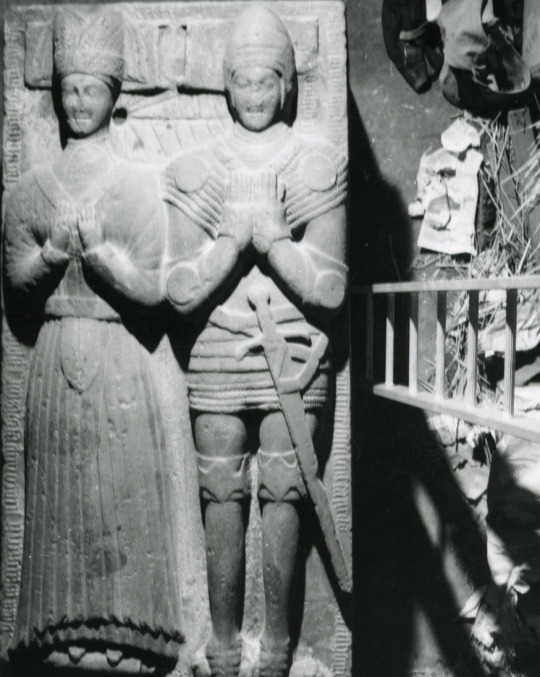
effigy of Margaret Janico and husband at St. Audoen's Church, Dublin (photos, once again, by my man Edwin)
The headpiece in the drawing looks like a linen kerchief wound up to form a turban with a decorated fillet tied over it. The headpiece on the effigy is probably actually a truncated hennin with a veil pinned to it like the one in this mid-15th c Burgundian painting by Petrus Christus.
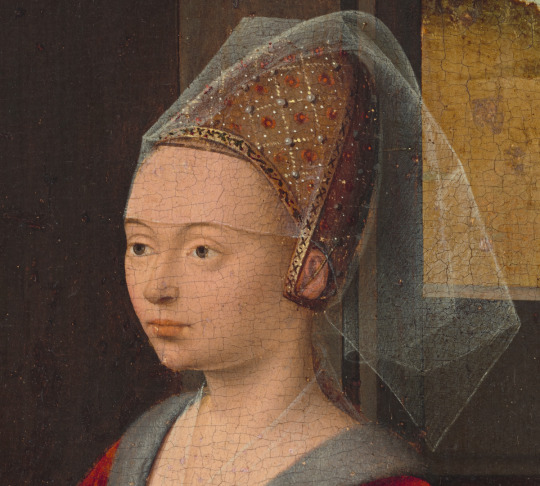
16th century:
Plate 9 is based on Katherine Molloy's early 16th c. effigy at Fertagh Church, in County Kilkenny. According to the artist's notes it was in "nearly perfect" condition at the time. I wish he had put more detail into the drawing.
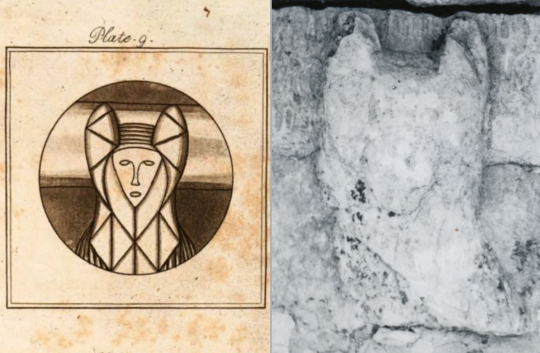
(photo also by Edwin Rae)
17th century:
Plate 10 is based on The Taking of the Earl of Ormond in anno 1600. Walker's artist clearly fabricated some detail here, falsely giving the impression that triús were ankle-length. We know from extant examples from Kilcommon, Dungiven, and Killery that triús actually extended past the ankle, covering part of the wearer's foot (Dunlevy 1989, Henshall et al 1961).

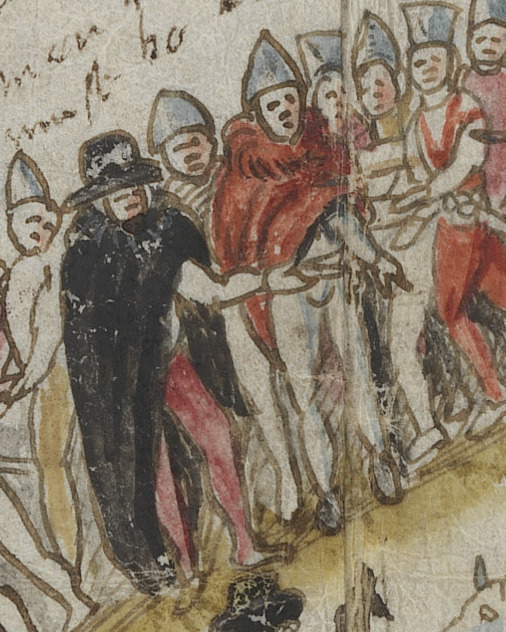
Plate 11 was taken from the tomb of Sir Gerald Aylmer (died 1634) and Juliana Nugent. Sadly, it appears to have been destroyed in the early 19th c, so I have no further pictures of it. The clothing looks to me like typical 1630s English fashion with loose gowns over doublets, falling bands, and linen cuffs.

? Century
Plate 1 figure 4 is apparently from Old Kilcullen, County Kildare. I am not sure what this is based on. I haven't seen any Santa hats at Old Kilcullen. Or anywhere else in Medieval Ireland.
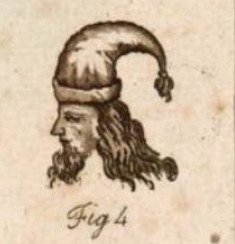
Bibliography:
Dunlevy, Mairead (1989). Dress in Ireland. B. T. Batsford LTD, London.
Henshall, Audrey, Seaby, Wilfred A., Lucas, A. T., Smith, A. G., and Connor, A. (1961). The Dungiven Costume. Ulster Journal of Archaeology, 24/25, 119-142. https://www.jstor.org/stable/20627382
Edwin Rae's invaluable collection of photographs of Late Medieval Irish art accessed via TARA.
#15th century#irish dress#dress history#irish history#art#early medieval#16th century#historical women's fashion#historical men's fashion#historical fashion#hiberno norman#gaelic ireland#headwear
12 notes
·
View notes
Text
3h should've had peasant revolts bc the early modern period (which 3h draws a lot of inspiration from and references towards) had a lot of peasant revolts and peasant uprisings and also because peasant uprisings are awesome and cool
#stop saying 3h is a medieval war game. it is not. it is an early modern war game#1. shakespeare references 2. waning power of the church 3. rise of merchants as a political class#4. the fashion 5. the food buildings etc#6. it goes out of its way to explain why they aren't using muskets
5 notes
·
View notes
Text
Also off topic but in case anyone's curious, my mcd designs are an odd mix of both medieval and renaissance fashions bc if it can have immortal elves and catgirls, then I'm allowed to use different time periods
#mcd#minecraft diaries#i stick within the 13-15th centuries typically so its not TOO crazy of differences#early history fashion (esp in the medieval era) DEFINITELY changed but generally stayed similar enough that i decided i could get away#with it lol#original i was like 'lets stick to one century!!' but BOOO im gonna do what I want LOL
35 notes
·
View notes
Text
why did game of thrones costume design get so ugly why was that allowed
#i'll be thinking about a scene i like in asoiaf and go 'i want to look for illustrations of this' and i google it and#see a GoT version of that scene and the things they dressed these actors in#i don't care so much about 'anachronism' in a fantasy world but i do think it should at least look#medieval inspired? or at least. 'oh yeah i can see this being fashionable and technologically feasible for these people'#they were better about that in early seasons iirc
0 notes